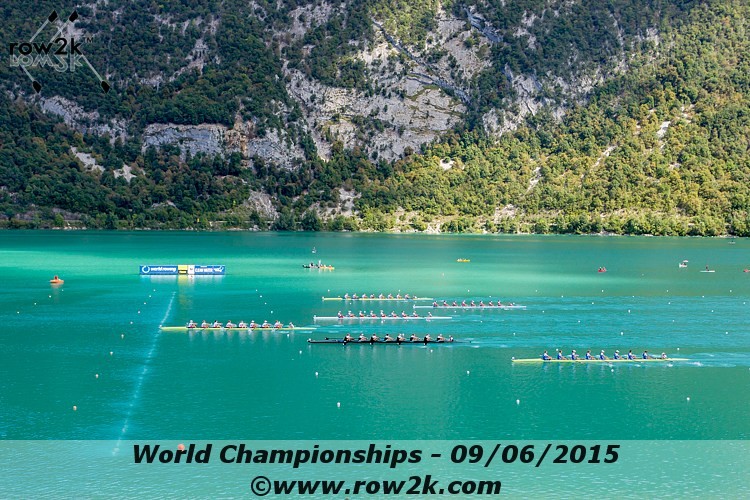Dr. Valery Kleshnev, BioRow.com

Dr. Valery Kleshnev, a sports scientist and data expert who won a silver medal in the men's quad in 1980, runs BioRow, a research & development and consulting company company based in the UK. In addition to his work with rowing data, Dr. Kleshnev consults with national teams, universities, clubs, and individuals looking to improve performance through the use of rowing biomechanics and help rowers to row faster and more effectively. Learn more about the products and services, webinars, books, and more offered by Dr. Kleshnev at http://biorow.com/.

The trends in rowing speeds over last 27 years (from 1993 till 2019) were recently discussed with Dr Volker Nolte, and he voiced his concern about the decrease in speed over the last decade. As speed is significantly affected by random weather conditions, it has high variation from year to year and the trends may not be statistically reliable.
In an attempt to minimise the random factor and extract trustworthy trends, the speed of the winners of the Olympics and Worlds was analysed in decades, starting from 1993-2003, 1994-2004, 1995-2005, 2009-2019 with a total amount of 17 decades. In each decade, linear trends of rowing speed were determined and their slopes (the speed growth per year) were analysed (Fig.1).

The growth was consistently positive until 2001-2011, then it became negative in all decades except 2004-2014, because the tailwind at Worlds 2014 in Amsterdam made it the fastest regatta ever. Approximation of this tendency with a third-order general trend shows that it is well determined statistically (r2=0.84), which means the random factor explains only 16% of its variation. The general trend of rowing speed became negative in 2007 (corresponding decade 2002-2012), and remains negative but stable, without further decrease.
In most boat types, the trends were similar to the average (Fig.2) with some specifics. In men's sculling, M1x and M2x had very similar general trends, with the smallest variation over decades and a slight increase back to zero in the last decade. In M4x, the general trend was more variable and remains negative.
In women's sculling, W1x had continuous improvement over the last five decades and has reached zero in the last one. W2x and W4x had fewer variable trends, but now they remain negative.
In men's sweep boats, M2- had the longest period with positive trends, until 2005-2015 decade, which could be explained by the outstanding performances of the Australian and New Zealand pairs, Olympic champions in 2004-2008 (Tomkins-Ginn-Free) and 2012-2016 (Bond-Murray). After these crews retired, M2- trends became the most negative among other boats (-0.43%). The general trend in M8+ is improving and became positive during the last decade 2009-2019, but the M4- trend has remained negative since the 2000-2010 decade.

In women's sweep, W2- trends are the most variable: they changed sign three times, so the general trend was slightly positive, but became negative in the last decade. W8+ had the most positive general trend (+0.18%) with only 4 negative decades from 17, and now a significantly improving general trend with positive values over the last three decades. This confirms our previous findings that W8+ speeds have the fastest growth among all Olympic rowing events (RBN 2019/08).

In both lightweight doubles, the general trends are very similar to the average, they became consistently negative after the 2000-2010 decade with some tendency to improvement.
To double check the above findings, another method was used: average winner's speeds in 13 Olympic boats over 1993-2019 were ranked, then the data was filtered to reject the fastest and slowest speeds outside the ranges ±1.0SD (30% of the total 27 points were rejected) and ±0.5SD (60% rejected), which should minimise the effect of random weather conditions. Second-order polynomial trends were built over all three data sets (Fig.3).

All three trends confirm the above findings: rowing speed achieved its peak in 2006-2008, and then results continuously decreased.
©2020 Dr. Valery Kleshnev www.biorow.com
If you enjoy and rely on row2k, we need your help to be able to keep doing all this. Though row2k sometimes looks like a big, outside-funded operation, it mainly runs on enthusiasm and grit. Help us keep it coming, thank you! Learn more.
Comments | Log in to comment |
- Bont Rowing
- Calm Waters Rowing
- Concept 2
- Craftsbury Sculling
- The Crew Classic
- CrewLAB
- Croker
- Durham Boat Co.
- Empacher
- Faster Masters
- Filippi
- Fluidesign
- h2row.net
- HUDSON
- Live2Row Studios
- Nielsen-Kellerman
- Oak Ridge RA
- Peinert Boat Works
- Pocock Racing Shells
- Race1 USA
- RowKraft
- Rubini Jewelers
- Vespoli USA
- WinTech Racing
- Bont Rowing
- Calm Waters Rowing
- Concept 2
- Craftsbury Sculling
- The Crew Classic
- CrewLAB
- Croker
- Durham Boat Co.
- Empacher
- Faster Masters
- Filippi
- Fluidesign
- h2row.net
- HUDSON
- Live2Row Studios
- Nielsen-Kellerman
- Oak Ridge RA
- Peinert Boat Works
- Pocock Racing Shells
- Race1 USA
- RowKraft
- Rubini Jewelers
- Vespoli USA
- WinTech Racing


















12/09/2020 12:43:21 PM
12/09/2020 8:35:06 PM
12/13/2020 9:46:16 PM